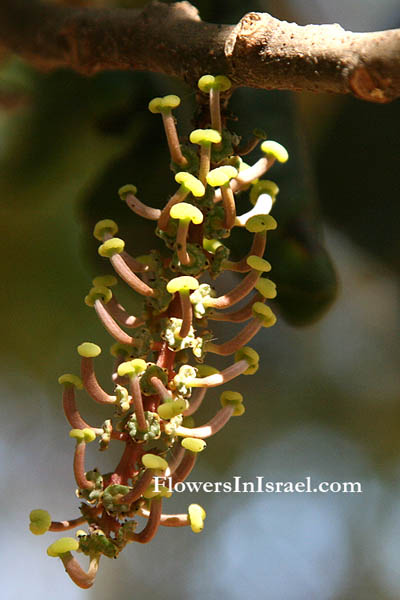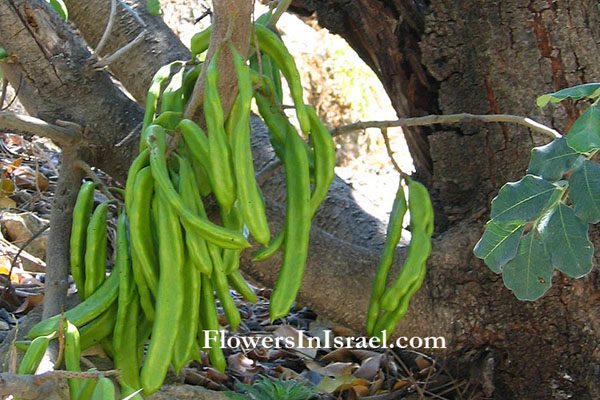Egyptian fig, חרוב מצוי "Charuv", خروب "kharoub"
| Scientific name: | Ceratonia siliqua L. | |
| Common name: | Carob, St. John's-Bread | |
| Hebrew name: | חרוב מצוי "Charuv" | |
| Arabic name: | خروب "kharoub | |
| Plant Family: | Caesalpiniaceae, Senna Family, קסאלפיניים |

|
| Life form: | Tree | |
| Stems: | 15-17 m in height | |
| Leaves: | Alternate, compound, pinnate, smooth | |
| Flowers: | Green | |
| Fruits: | pod light- to dark-brown, oblong, flattened, straight or slightly curved, with a thickened margin; 10-30 cm long, 1-2.5 cm wide, glossy, tough and fibrous; 10 to 13 flattened, very hard seeds which are loose in their cells and rattle when the pod is fully ripe and dry. | |
| Flowering Period: | August, September, October, November | |
| Habitat: | Mediterranean maquis and forest | |
| Distribution: | Mediterranean Woodlands and Shrublands, Semi-steppe shrublands, Shrub-steppes, Montane vegetation of Mt. Hermon | |
| Chorotype: | Mediterranean | |
| Summer shedding: | Perennating |

Derivation of the botanical name: Ceratonia, keration (Greek), keras, "horn" and refers to the fruit of the carob. siliqua (Latin), alluding to the hardness and shape of the pod. The Carob tree from Arabic: خروب "kharoub" and Hebrew: חרוב Charuv. The etymology of the word is from the sword shaped pod - herev חרב is sword in Hebrew. The word passed from Hebrew to Aramaic חרובא, and from Aramaic to Arabic harrubah. In the Middle Ages, it passed from Arabic to the European languages - caroube in French, carruba in Italian and carob in English.
The term "carat", the unit by which diamond weight is measured, is derived from the Greek word keration, alluding to an ancient practice of people in the middle east weighing gold and gemstones against the seeds of the carob tree. The seeds of the fruit of the Carob tree weigh always between 197 and 216 milligram. Already in antiquity these seeds were used as a weight unit. Just at the beginning of the twentieth century the metric carat (see: carat) was determined internationally on 0.2 gram. Ceratonia siliqua, Carob, is often called the poor man's bread and it is regarded as a symbol of humility. The Carob Tree or Locust (the ´husks´ of which were fed to the swine -Luke.15:16), also known as St John's Bread (Mark 1:6). Legend says John the Baptist sustained himself on the Carob beans while travelling in the wilderness. This particular reference has been rather misunderstood. John the Baptist has been reported to survive during his time in the dessert eating locusts (insects). This reference has been confused with Locust Bean which is another word for carob. It is well known that in Biblical times wild (non cultivated) carobs were in abundance and it is not mentioned in the Old Testament; its Hebrew name haruv often appears in the Mishnah and the Talmud. Furthermore ancient Greeks recorded that the Egyptians called this particular tree the "Egyptian Fig". The Egyptians not only ate the pods raw but used the gum out of the seeds (LBG) to produce a liquid which they widely used in the mummification of their dead. The Carob tree together with the Mastic pistacia bush (Pistacia lentiscus) dominate a type of evergreen scrub forest, called the Carob and Mastic Pistacia Scrub Forest. It is common in the Coastal Plain and the adjacent foothills, and on the eastern slopes of Galilee and Samaria. The Carob tree is an leguminous evergreen shrub or tree of the family Leguminosae (pulse family), native to the Mediterranean region, cultivated for its edible seed pods.
The pods are brown, usually straight and 10-20 cm long. The walls of the pod and the partitions in the fruit contain very high concentrations of sugar, more minerals and vitamins, and less carbohydrates and fat than cocoa. The pods are rich in protein and sugar and have often been proclaimed "wholesome for man or beast". The pulp is a valuable sweetener and chocolate substitute and the roasted seeds have even been used as a coffee substitute. The seeds constitute 10 to 20% of the pod. They yield a tragacanth-like gum (manogalactan), in the trade called "Tragasol", which is an important commercial stabilizer and thickener in bakery goods, ice cream, salad dressings, sauces, cheese, salami, canned meats and fish, jelly, mustard, and other food products. The seeds and pods can be fermented and distilled, with the drink retaining the appealing flavor of the pods. The seeds ground up produce a protein rich flour that contains no starch or sugar and is ideal for diabetics. In Western Europe the roasted seeds have served as a substitute for coffee. In Spain, they have been mixed with coffee. A mature tree can produce over 400 pounds of pods and seeds annually. In 1811 and 1812, these pods were the principle food for the British Cavalry during the war and they have been much used as fodder. At one time, the seeds were in high demand by chemists, as singers thought that they cleared the throat. Even medicinal uses have been found for the pods, with laxative and demulcent qualities being associated with them. Dried carob fruit is traditionally eaten on the Jewish holiday of Tu Bishvat. Although the carob is not mentioned in the bible, its seeds are. See the list of Medicinal herbs in Israel, the parts used and their medical uses to treat various diseases. Bible resources:


|
